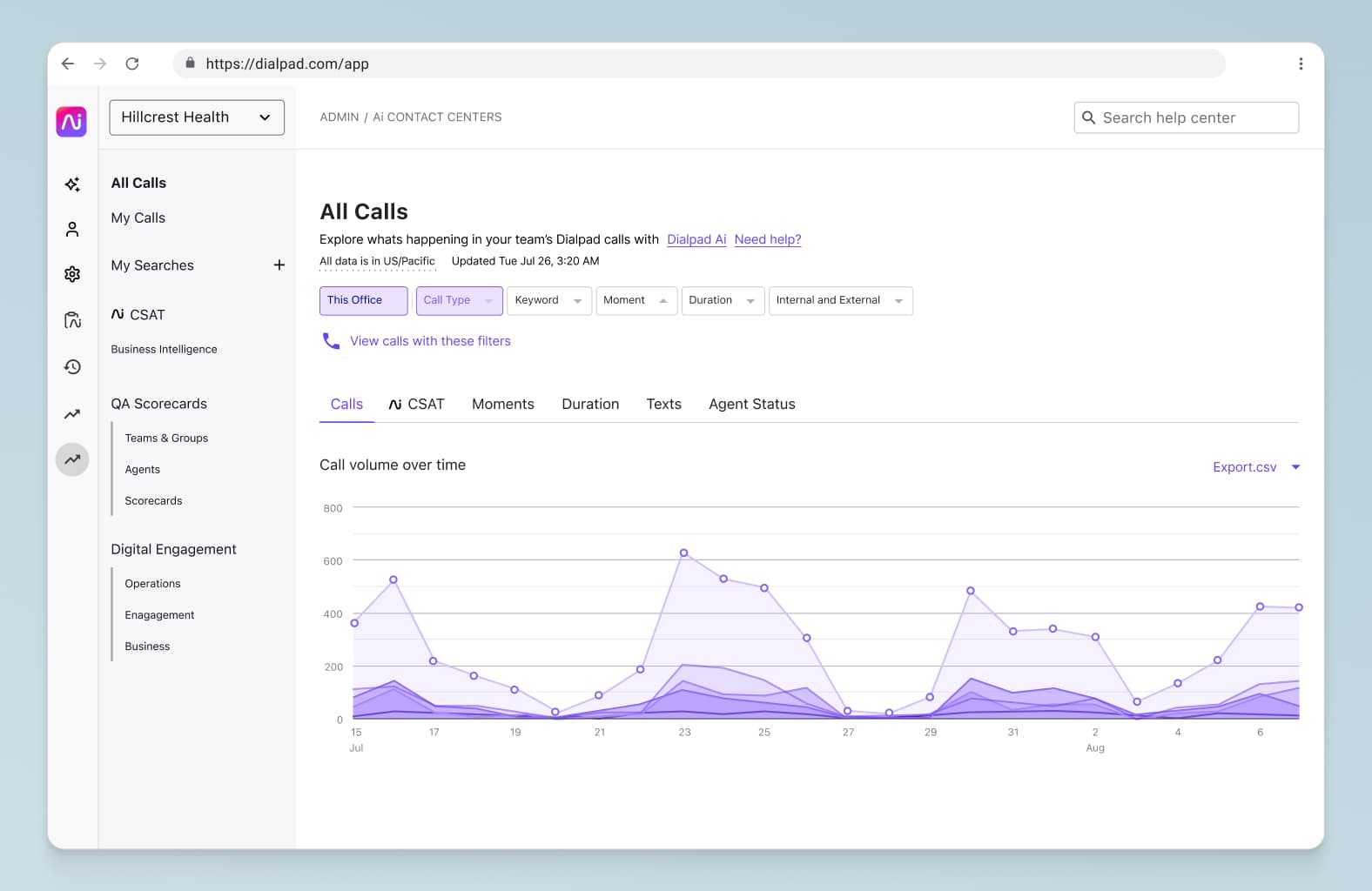Real-world contact center lessons to improve the patient experience

Director of Content

Tags
Share
There's been no shortage of think pieces about how the pandemic has put increased strain on the relationship between the healthcare industry and the public.
One big reason for this strain? From our conversations with clinics. and practices, it's the fact that organizations are quickly realizing that their communications technology is—how shall we put it?—clunky, isolated, and seriously outdated.
While most businesses care about "customer satisfaction" and the digital customer experience, there are very similar parallels in healthcare, you've got the patient experience to manage. Between the pressures of increased patient populations and employee expectations around remote and hybrid work, healthcare providers have got their work cut out for them.
In this blog post, we'll look at different ways in which real-world practices and providers are using healthcare call center and contact center solutions to not only provide a better patient experience and increase retention, but also empower their employees to work more efficiently—and effectively.
Does your healthcare contact center work remotely?
Learn about remote + hybrid work best practices when it comes to healthcare communications in this guide!
A few examples of real-world healthcare contact centers
Whether you operate a hospital, doctor’s clinic, health insurance company, or wellness center, your medical call center or hosted contact center solution is a critical link between your patients and your physicians, providers, and administrators.
Here are just a few examples of the many different use cases for healthcare contact center solutions.
Health insurance contact centers
Health insurance call centers handle the processing of insurance claims, insurance technology, and other patient services like premium payments and information distribution. Today, with live chat and channels other than phone calls becoming more popular, these healthcare call centers have evolved to become contact centers.
General contact center
Again, while a call center exclusively handles phone calls, a contact center provides an omnichannel experience and can handle customer interactions across multiple channels of communication.
Whether it’s two-way SMS, email, live chat, or social media messaging, contact centers aim to create an access point for every stage in a patient’s journey. At this point though, the telephone still reigns supreme—76% of people still prefer to contact customer services via phone.
📚 Further reading:
Check out Dialpad's State of AI in Customer Service Report for the latest insights about AI's impact on businesses and contact centers, based on a survey of over 1,000 CX professionals.
Inbound call center
Inbound call centers exclusively handle incoming calls. This often involves resolving patient problems, answering queries, scheduling appointments, or making referrals.
👉 Fun fact:
Contact center agents used to all have to sit in one big room with rows and rows of computers and screens, but today, many have adapted to working remotely. In fact, with modern contact center solutions, it’s possible for entire contact center teams to work remotely. (Like Fenway Health! More on their story later...)
Outbound call center
This use case is a bit rarer, but on occasion you'll see outbound call centers in healthcare, which focus on making outgoing calls, sometimes for outreach or patient engagement, or possibly even fundraising.
What common issues can a cloud healthcare call center solution solve?
The healthcare industry faces some unique communication challenges on a daily basis—and many of these can actually be mitigated by a good contact center or call center platform.
Post-op follow-up/appointment reminders are delayed
Did you know that 37% of patients miss appointments—simply because they forgot or didn’t know they had an appointment in the first place? A contact center solution can help you streamline your patient outreach process by automating appointment, follow-up, and aftercare reminders. This can significantly reduce the impact of missed appointments.
High call volumes
If your organization or practice is good at what it does, the demand for your healthcare services should grow—and so will your call volumes. And if you're doing really well, this will eventually become overwhelming for front desk staff and ultimately result in missed calls and high abandoned rates.
If you run a healthcare practice organization with many locations and distributed employees, for example, you might receive a high volume of calls from patients and prospective patients on a daily basis. In this case, it would be helpful to have insight into what is causing the high call volumes.
With Dialpad Ai Contact Center, for example, you'd be able to see when call volumes are spiking with the built-in heat maps.
Expensive and time consuming infrastructure upgrades
With on-premises solutions, continuous manual upgrades are mandatory to make sure you can keep up with patient demands—but upgrading legacy infrastructure incurs significant short and long-term costs. It can also wreak havoc on your downtime, leaving you with impatient, dissatisfied customers.
Cloud call center services can minimize these costs and resource demands for healthcare practices, since the provider takes care of all those upgrades and software updates for you. (There's also outsourcing, which is another option that can take many tasks and costs off your internal teams' plates—but in healthcare, this can be tricky to do. IPM Medical Group gave outsourcing a try as well, but found that it wasn't for them.)
Long call waiting times
Keep your patients (or potential patients) waiting long enough, and they might just hang up and never return. Even if they do resist the urge to hang up the phone in frustration, chances are they’re not going to be very happy with the agent taking the call.
With Dialpad, you can make certain that your contact center is operating in compliance with your service level agreement (SLA). You can use Dialpad’s contact center analytics to do just that—at a glance, easily see whether you're reaching your target of answering calls in a certain length of time:

5 healthcare contact center best practices (with real-world examples)
Want to optimize your call center operations? Here are some contact center and call center best practices—as illustrated by real-world healthcare clinics and organizations.
1. Be prepared with a scalable, and unified platform: Fenway Health
Does your current platform integrate seamlessly with your existing tools and apps?
Does it offer your staff the flexibility to work from home if needed?
If you needed to, could you add new users and phone lines with just a click of a button?
A good cloud contact center platform should do all three. For example, with Dialpad, you can manage phone numbers and add agents to your contact center team in minutes, right from your online dashboard:

In fact, Fenway Health's IT Director, Jon, was able to send call center agents home without any hardware, “We didn’t have equipment to send home with folks—they were able to use smartphones and web browsers to access the call centers, and our call center service levels were unaffected. It was a very easy transition."
2. Integrate your contact center with your CRM: IPM Medical Group
Most healthcare providers and clinics use some sort of CRM. Whether it's Salesforce or a homegrown CRM, it can make life a lot easier for agents and supervisors if it integrates with your contact center platform. Dialpad, for example, integrates with Salesforce, HubSpot, Zendesk, and more.

Jay, IPM Medical Group's, Director of Technical Development, says that a good Zendesk integration is crucial to their workflows, “We can separate out the different calling party types, like if a patient or medical clinic calls. Then—what is the topic they’re calling about? How did it get resolved, and what other actions were taken. If it’s something that needs to get forwarded to another department, we can immediately change the Zendesk form to the form of the applicable department and it gets picked up in the next team’s workflow.”
3. Shadow agents on calls and do real-time coaching: Metropolitan Pediatrics
Don’t just throw your newly-trained call center agents into the deep-end. Offer them some reassurance (and satisfy any impatient, er, patients) by having an easy way to coach or guide your agents’ calls in real time.
Dialpad Ai, our artificial intelligence technology, for example transcribe calls in real time, and can even do live sentiment analysis to track if calls are going positively or negatively. If a call appears to be turning sour, supervisors can take a quick look at the live-updated transcript and jump in to mitigate if needed:

That’s not all—if supervisors notice that certain topics keep giving agents trouble, they can create Real-time Assist (RTA)cards with tailored notes that pop up when certain keywords are spoken. This way, they can make sure agents are getting the help they need, without personally helping on every call:

Kathy, the Practice Manager at Metropolitan Pediatrics, says that it's a great QA tool. “If someone forgot something, they can look back and see the conversation. And of course, if there’s a tense conversation or someone makes a complaint about somebody, we can review it to see what happened.”
4. Review analytics around call length regularly to optimize routing: CareRev
Tracking your key performance indicators (KPIs) is essential for your quality assurance strategy, because it give you actionable insights into each agent’s performance. With Dialpad’s analytics features, you can (and should!) be consistently tracking KPIs like average time to answer, first call resolution, and more.
Dialpad's call analytics dashboard shows you overall metrics like how many calls are being answered, missed, and so on:

With this data (and Dialpad's Playvox WFM and QM integrations), you can make more informed decisions around things like staffing, routing and call queue strategy.
Dionne, CareRev's Customer Support Operations Manager, says, “Dialpad helps me be a better manager. The notifications I receive go straight to my phone to let me know how many agents are available and how many callers are waiting in the queue, and if someone has been waiting over five minutes to get through to the agent. It also lets me know if the amount of calls coming in has dropped a certain percentage compared to how many should be answered within a certain time. It just keeps me aware of what's going on day-to-day.”
With Dialpad's Interactive Voice Response (IVR) feature, you can easily set up and make changes to your call routing flows and help patients self-service, which reduces triage work for your staff and can reduce the burden of inbound calls.
One useful thing that Dialpad's analytics can show is how frequently each IVR menu option is being used by your callers:

5. Make sure tools are HIPAA-compliant: Proliance Surgeons
Making sure your software is compliant, whether it's your phone system, contact center solution, or Electronic Health Records (EHR) system should be at the top of any healthcare organization's priority list if you want to avoid serious financial, reputational, and legal repercussions.
For Proliance Surgeons, which is one of the biggest surgical practices in the US with over 80 care centers, HIPAA compliance is absolutely crucial. “Our physicians know that their confidential data is secure and protected from things like ransomware. And if we have a disaster, they know that data is available so their work will be uninterrupted,” says Curt Kwak, their CIO.
Even though sometimes patients still need to come in physically for surgical consults or diagnosing injuries, Proliance Surgeons’ team can use Dialpad for when appointments can be done over secure video calls.
Which of these healthcare contact center best practices will you implement?
With a good contact center solution and the right strategies in place, healthcare organizations can empower both agents and supervisors to provide a better patient experience.
Dialpad’s contact center solution can help you to drive patient-centric processes into the heart of your clinic or practice. With flexible call routing, built-in artificial intelligence, and in-depth call analytics, you can make sure that your patient experience truly reflects the quality of your patient care.
Looking for a healthcare-focused contact center solution?
See how Dialpad Ai Contact Center can work for you by booking a product demo, or take a self-guided interactive tour of the app on your own first!









